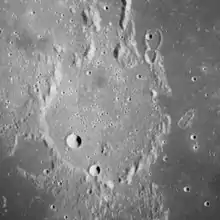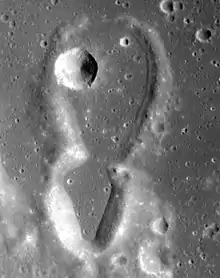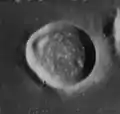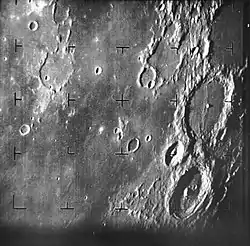Guericke (crater)
Guericke is the remnant of a lunar impact crater at the north part of the Mare Nubium. It is named after German scientist Otto von Guericke.[1] To the north-northwest lies the large Fra Mauro crater, along with the co-joined craters Parry and Bonpland. To the east are the craters Kundt and Davy.
 Apollo 16 mapping camera image | |
| Coordinates | 11.5°S 14.1°W |
|---|---|
| Diameter | 61 km[1] |
| Depth | 0.7 km |
| Colongitude | 14° at sunrise |
| Eponym | Otto von Guericke |

The surviving rim of Guericke has been worn, battered, and partly submerged by the basaltic lava that covers the floor. The wall is now little more than a circular series of ridges that join with rises that flow to the north, northwest, and south. The flooded crater remnant Guericke F is attached to the southwest exterior. The interior flood has a few small rises in the otherwise nearly flat surface. Two craters (Guericke D and H) mark the floor in the southwest quadrant.
Satellite craters
By convention these features are identified on lunar maps by placing the letter on the side of the crater midpoint that is closest to Guericke.
| Guericke | Latitude | Longitude | Diameter |
|---|---|---|---|
| A | 11.1° S | 17.3° W | 5 km |
| B | 14.5° S | 15.3° W | 16 km |
| D | 12.0° S | 14.6° W | 8 km |
| E | 10.0° S | 12.0° W | 4 km |
| F | 12.2° S | 15.3° W | 21 km |
| G | 14.0° S | 15.0° W | 5 km |
| H | 12.4° S | 14.2° W | 6 km |
| J | 10.6° S | 13.4° W | 8 km |
| K | 15.1° S | 13.3° W | 3 km |
| M | 12.9° S | 12.5° W | 2 km |
| N | 12.5° S | 9.9° W | 3 km |
| P | 15.0° S | 14.6° W | 3 km |
| S | 10.3° S | 13.3° W | 11 km |
 Guericke B from Lunar Orbiter 4
Guericke B from Lunar Orbiter 4 Guericke B from Apollo 16
Guericke B from Apollo 16
The following craters have been renamed by the IAU.
- Guericke C — See Kundt.
References
- Guericke, Gazetteer of Planetary Nomenclature International Astronomical Union (IAU) Working Group for Planetary System Nomenclature (WGPSN)
- Andersson, L. E.; Whitaker, E. A. (1982). NASA Catalogue of Lunar Nomenclature. NASA RP-1097.CS1 maint: ref=harv (link)
- Bussey, B.; Spudis, P. (2004). The Clementine Atlas of the Moon. New York: Cambridge University Press. ISBN 978-0-521-81528-4.CS1 maint: ref=harv (link)
- Cocks, Elijah E.; Cocks, Josiah C. (1995). Who's Who on the Moon: A Biographical Dictionary of Lunar Nomenclature. Tudor Publishers. ISBN 978-0-936389-27-1.CS1 maint: ref=harv (link)
- McDowell, Jonathan (July 15, 2007). "Lunar Nomenclature". Jonathan's Space Report. Retrieved 2007-10-24.CS1 maint: ref=harv (link)
- Menzel, D. H.; Minnaert, M.; Levin, B.; Dollfus, A.; Bell, B. (1971). "Report on Lunar Nomenclature by the Working Group of Commission 17 of the IAU". Space Science Reviews. 12 (2): 136–186. Bibcode:1971SSRv...12..136M. doi:10.1007/BF00171763.CS1 maint: ref=harv (link)
- Moore, Patrick (2001). On the Moon. Sterling Publishing Co. ISBN 978-0-304-35469-6.CS1 maint: ref=harv (link)
- Price, Fred W. (1988). The Moon Observer's Handbook. Cambridge University Press. ISBN 978-0-521-33500-3.CS1 maint: ref=harv (link)
- Rükl, Antonín (1990). Atlas of the Moon. Kalmbach Books. ISBN 978-0-913135-17-4.CS1 maint: ref=harv (link)
- Webb, Rev. T. W. (1962). Celestial Objects for Common Telescopes (6th revised ed.). Dover. ISBN 978-0-486-20917-3.CS1 maint: ref=harv (link)
- Whitaker, Ewen A. (1999). Mapping and Naming the Moon. Cambridge University Press. ISBN 978-0-521-62248-6.CS1 maint: ref=harv (link)
- Wlasuk, Peter T. (2000). Observing the Moon. Springer. ISBN 978-1-85233-193-1.CS1 maint: ref=harv (link)
External links
| Wikimedia Commons has media related to Guericke (crater). |
Related article
- Wood, Chuck (May 12, 2006). "LPOD is Back Again". Lunar Photo of the Day. Archived from the original on June 14, 2011.
